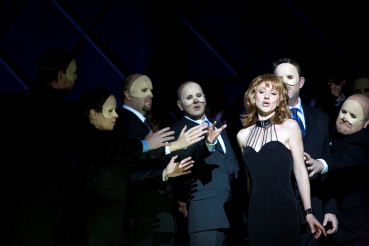|
Editorial Board
Melanie
Eskenazi
Webmaster: Len Mullenger
|
Seen and Heard International
Opera Review Verdi
La
traviata
at
the Royal Opera, Stockhom, 20.1.2007. New Production Premiere
(GF)
Lighting: Jesper Kongshaug
Direction: Kasper Bech Holten
Conducted by Antonello Allemandi Cast:
Flora Bervoix –
Paula Hoffman
Annina 1 –
Katarina Böhm
Annina 2 –
Monika Mannerström
Alfredo Germont
– Tito Beltrán
Giorgio Germont
– Karl-Magnus Fredriksson
Gastone de
Létoričres – Klas Hedlund
Baron Douphol –
Per-Arne Wahlgren
Marquis d’Obigny
– Lennart Forsén
Doctor Grenvil – Mikael Axelsson A
servant – Thomas Annmo A
messenger – Jan Sörberg
Chorus and orchestra from the Royal Opera
It
is a raw, brutal world, where warmth is in short supply
and carnal desire and money rules the individuals. Flora,
far from being the traditional confidante of Violetta,
is rather hostile and bossy, the accountant dominating
over the fellow-creature; the baron, who should have at
least some dignity, is constantly hot-tempered and aggressive,
kept from using his fists only by the marquis, in white
suit, who in between is a horny, laughing creature, pawing
every female within reach. In the Flora scene, after Alfredo
has humiliated Violetta, Germont takes him to task for
what he has done but here words are obviously not enough,
he gives him a couple of sound boxes on the ear – humiliation
acknowledged. Most cruel of all: Violetta’s death scene.
Her “friend” Doctor Grenvil reluctantly examines her when
passing by, all too eager to get away to more lucrative
customers and when she dies Germont immediately more or
less drags Alfredo – the only character besides Violetta
with a heart – off stage. It is a hard, cold, callous
world and this production lays this bare more graphically
than any other I have seen. I am still not convinced that
the central conflict in this opera – that Alfredo’s relation
to a woman who hasn’t got the best of reputations – is
applicable on the early 21st century, but apart
from this – and a couple of places where the modern setting
jars with the text – this is one of the most successful
reallocations of a standard classic opera I have seen.
In
accordance with the production maestro Allemandi’s conducting
is also fairly hard-driven, tempos generally on the fast
side without being as relentlessly rushed as on Toscanini’s
famous recording. The first act prelude, so important
as a poster for the performance, tells us at least something:
it is beautifully shaped with extremely well judged nuances
but also with some unusually heavy accents – not vulgar
but making one listen and think: what is to follow? Especially
in the first scene the orchestra also threatens to drench
the voices, but that is very much an exception. Maestro
Allemandi knows his Verdi and also manages to avoid the
Puccinian sentimentality that some conductors love to
inject in this score. Verdi had sentiment but he was also
an objective observer. I regret though that the off-stage
dance music in the first scene is so distant that I first
suspected that the band had been delayed by the snowstorm
that affected Stockholm this evening.
Besides the three central
characters all the others are comprimarios but as such still important, not
least as actors. As the choleric Baron Douphol (veteran Per-Arne Wahlgren) and
the randy Marquis d’Obigny (Lennart Forsén) dominated the two party scenes, both
through their physical stature and ebullient personalities. Neither of them was
in very good voice but that hardly mattered. Paula Hoffman was a rather reticent
Flora while the ever reliable Klas Hedlund made a both vocally and scenically
splendid Gastone.
But of course a
Traviata performance stands or falls with the three main characters. Here
the Royal Opera had chosen to match two international guests with Karl-Magnus
Fredriksson’s impressive Germont. I have praised him before: last spring he was
a superb Count Luna in Il trovatore and the year before his Eugene Onegin
was in the same class. As Germont he managed to look – and even move – properly
elderly. He can be scenically efficient with small means, something that suits
the stiff and restrained Germont well, while his singing sent shivers down the
spine, not least in a masterly Provence aria, where he was also granted the
cabaletta. In the long second act scene with Violetta, the peripeteia of this
work, he was able to give a full-size portrait of the egotistic father, caring
no doubt about poor Violetta and showing some compassion but in the last resort
more than eager to get this encounter done with.
His son, Alfredo, was
Chilean tenor Tito Beltrán, who has lived in Sweden since 1986 and is well
established as one of the most popular artists in a wide field – a Swedish
Andrea Bocelli but with better voice. It is a pity that he too often pushes his
voice too much, resulting in a bleating tone quality. Basically he is a
lirico-spinto and some more honey in the voice shouldn’t come amiss but he is
willing to sing softly when required and in the last act duet with Violetta,
Parigi o cara, he sang the first stanza with trembling, half-choked voice,
overcome by the grief since he had realized that she was going to die. And he
has truly heroic, ringing top notes. He was a little less convincing as an actor
but still made a believable Alfredo.
Italian soprano Maria
Costanza Nocentini was, I believe, a new acquaintance for the majority of the
audience. I came across her quite recently when reviewing the Naxos La figlia
del Reggimento, and I wasn’t wholly enthusiastic then, although I found
positive qualities. She has a somewhat tremulant voice and in the first scene
this was the overriding impression, but she grew during the performance and her
acting was superb, making this a very believable Violetta. Her slim constitution
also made it quite possible that she could suffer from consumption. Sempre
libera was excellent and there she also found a bell like quality in the
coloratura. The long scene with Germont finally settled her as a superb Violetta.
In the second act the coloratura soprano has to transform into a lirico-spinto
in the Tebaldi mould. Quite that regal tone she couldn’t muster – who can? – but
she was magnificent even so and she topped her performance with a magically
vulnerable Addio del passato in the last act. She got well-deserved
standing ovations at the curtain call.
As a conclusion I am happy
to report that the question mark with which I arrived at the opera house was
distinctly straightened into a bold type exclamation mark when I left. The 1961
production I saw so many times in my relative youth survived no less than 201
performances; this new one is worth the same longevity. Göran
Forsling
Back to the Top Back to the Index Page |
| ||
|
||||





